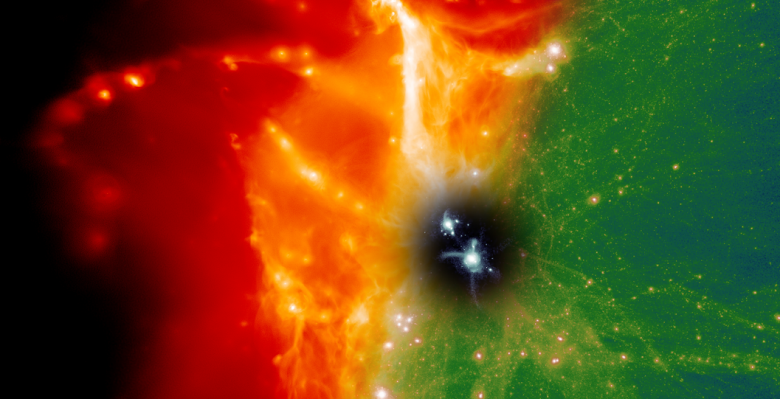Galaxies are "wasteful" and retain fewer materials needed to build stars and planets, says new study

Galaxies “waste” large amounts of heavy elements they generate via star formation by ejecting them up to a million light years away into their surrounding reservoirs of gas and beyond into deep space, according to a new study co-authored by Liverpool John Moores University (LJMU).
The research shows that more oxygen, carbon and iron atoms exist in the sprawling, gaseous halos outside of galaxies than within the galaxies themselves, leaving the galaxies with fewer of the raw materials needed to build stars, planets, and life itself.
Researchers from across the world contributed to the study, including Dr. Robert Crain, a Royal Society University Research Fellow at LJMU based in the Astrophysics Research Institute (ARI). Crain said of the findings: “The elements we are familiar with in our daily lives, such as carbon, oxygen and iron, are created by the stars that form in galaxies. Our findings indicate that most of the atoms forged throughout the formation of a galaxy are ejected in violent outflows of gas, driven by the growth of black holes and supernovae - the explosions that mark the death of massive stars”.
Dr. Benjamin Oppenheimer, a research associate in the Centre for Astrophysics & Space Astronomy (CASA) at Colorado University, and lead author of the study said: “Previously, we thought that these heavier elements would be recycled in to future generations of stars and contribute to forming planetary systems and providing the building blocks of life. As it turns out, galaxies aren’t very good at recycling.”
The near-invisible reservoir of gas that surrounds a galaxy, known as the circumgalactic medium (CGM), is thought to play a central role in cycling elements in and out of the galaxy, but the exact mechanisms of this relationship remain elusive. A typical galaxy ranges in size from 30,000 to 100,000 light years while the CGM can span up to a million light years.
The researchers used data from the Cosmic Origin Spectrograph (COS), a $70 million instrument designed at Colorado University, to study the composition of the CGM. COS is installed on NASA’s Hubble Space Telescope and uses ultraviolet spectroscopy to study the evolution of the universe.
Spiral galaxies like the Milky Way actively form stars and have a blueish colour while elliptical galaxies have little star formation and appear red. Both types of galaxies contain tens to hundreds of billions of stars that create heavy elements.
After running a new series of computer simulations, the researchers found that the CGMs in both types of galaxies contained more than half of a galaxy’s heavier elements, suggesting that galaxies are not as efficient at retaining their raw materials as previously thought. Crain remarked: “The remarkable similarity of the galaxies in our simulations to those targeted by the COS team enables us to interpret their observations with much greater confidence than before.”
The new simulations also explain the puzzling COS observation that there appears to be less oxygen around elliptical than spiral galaxies.
"The CGM of the elliptical galaxies is hotter," said Prof. Joop Schaye, an astrophysicist at Leiden University in the Netherlands and a co-author of the study. "The high temperatures, topping over one million degrees Kelvin, reduce the fraction of the oxygen that is five times ionized, which is the ion observed by COS."
By contrast, the temperature of the CGM gas in spiral galaxies is 300,000 degrees Kelvin, or around fifty times hotter than the surface of the Sun.
“It takes massive amounts of energy from exploding supernovae and supermassive black holes to launch all these heavy elements into the CGM,” said Oppenheimer. “This is a violent and longlasting process that can take over 10 billion years, which means that in a galaxy like the Milky Way, this highly ionized oxygen we’re observing has been there since before the Sun was born.”
Co-authors of the manuscript “Bimodality of low-redshift circumgalactic O VI in non-equilibrium EAGLE zoom simulations” include Alireza Rahmati of the University of Zurich (Switzerland); Alexander Richings of Northwestern University (United States); James Trayford, Richard Bower, Matthieu Schaller and Tom Theuns of Durham University (United Kingdom); and Jason Tumlinson of the Space Telescope Science Institute (United States).
Take a look at videos prepared by LJMU of a spiral galaxy here, much like our own Milky Way, and surrounded by hot gas, which only the Cosmic Origins Spectrograph (COS) installed on the Hubble Space Telescope can observe. Gaseous filaments, clumps, and other structures contain more mass than the stars in the galaxy, but this gas is so hot and diffuse that only an ultra-violet spectrograph like COS can probe it.
Videos courtesy of Adrien Thob at the ARI


